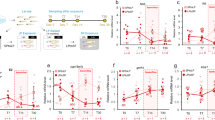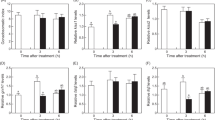Abstract
Photoperiod is a reliable cue to regulate growth and reproduction for seasonal adaptation. Although photoperiodism has been well studied in Chordata and Arthropoda, less is known about Mollusca. We examined photoperiodic effects on egg laying, body size, gonad-somatic index, oocyte size and relative amounts of caudodorsal cell hormone mRNA in individual rearing conditions in the pond snail Lymnaea stagnalis. Twenty-five weeks after hatching, the percentages of egg-laying snails under a photoperiod of 12 h light and 12 h darkness (12L:12D) were significantly smaller than those under longer days. The total numbers of eggs and egg masses under 12L:12D were significantly smaller than those under longer days. Significant differences between 16L:8D and 12L:12D were not observed in the soft body and ovotestis weight, and the gonad-somatic index. Photoperiodic effects were also not observed in oocyte diameters twenty-two weeks after hatching. Twenty-seven weeks after hatching amounts of caudodorsal cell hormone mRNA were significantly lower in the cerebral ganglia with commissure under 12L:12D than 16L:8D. L. stagnalis exhibited a clear photoperiodic response in egg laying and the amount of caudodorsal cell hormone mRNA, but not in gonadal development. Under 12L:12D suppression of caudodorsal cell hormone expression might suppress egg laying.




Similar content being viewed by others
Code availability
For statistical analysis, R “R” was downloaded from “https://cran.ism.ac.jp/”, “http://aoki2.si.gunmau-u.ac.jp/R/src/Steel-Dwass.R”, encoding = ”euc-jp”.
References
Bailey SE (1981) Circannual and circadian rhythms in the snail Helix aspersa Müller and the photoperiodic control of annual activity and reproduction. J Comp Physiol A 142:89–94
Bernheim SM, Mayeri E (1995) Complex behavior induced by egg-laying hormone in Aplysia. J Comp Physiol A 176:131–136
Berry RW (1982) Seasonal modulation of synthesis of the neurosecretory egg-laying hormone of Aplysia. Dev Neurobiol 13:327–335
Bohlken S, Joosse J (1982) The effects of photoperiod on female reproductive activity and growth of the freshwater plumonate snail Lymnaea stagnalis kept under laboratory breeding conditions. Int J Inver Rep 4:213–222
Bohlkena S, Joossea J, Geraerts WPM (1987) Interaction of photoperiod, grou** and isolation in female reproduction of Lymnaea stagnalis. Int J Inver Rep Dev 11:45–57
Cain GL (1956) Studies on cross-fertilization and self-fertilization in Lymnaea stagnalis. Biol Bull 111:45–52
Chase R (2002) Behavior and its neural control in gastropod molluscs. Oxford, New York
Denlinger D, Yocum GD, Rinehart JP (2012) Hormonal control of diapause. In: Gilbert LI (ed) Insect endocrinology. Academic Press, Cambridge, pp 430–463
Egonmwan RI (1991) The effects of temperature and photoperiod on growth and maturation rate of Limicolaria flammea Müller (Gastropoda: Pulmonata: Achatinidae). J Afr Zool 105:69–75
Fodor I, Hussein AAA, Benjamin PR, Koene JM, Pirger Z (2020) The unlimited potential of the great pond snail Lymnaea stagnalis. elife 9:e56962.
Geraerts WPM, Bohlken S (1976) The control of ovulation in the hermaphroditic freshwater snail Lymnaea stagnalis by the neurohormone of the caudodorsal cells. Gen Comp Endocr 28:350–357
Gomot P, Gomot L, Griffond B (1989) Evidence for a light compensation of the inhibition of reproduction by low temperatures in the snail Helix asperse. Ovotestis and albumen gland responsiveness to different conditions of photoperiods and temperatures. Biol Reprod 40:1237–1245.
Hermann PM, de Lange RPJ, Pieneman AW, Ter Maat A, Jansen RF (1997) Role of neuropeptides encoded on CDCH-1 gene in the organization of egg-laying behavior in the pond snail, Lymnaea stagnalis. J Neurophysiol 78:2859–2869
Hubendick B (1951) Recent Lymnaeidae Their variation, morphology, taxonomy, nomenclature, and distribution. Kungl Svenska Vetensk Akad Handl 3:1–223
Hussein AAA, Baz ES, Mariën J, Tadros MM, El-Shenawy NS, Koene JM (2020) Effect of photoperiod and light intensity on learning ability and memory formation of the pond snail Lymnaea stagnalis. Invertebr Neurosci 20:18
Joosse J (1984) Photoperiodicity, rhythmicity and endocrinology of reproduction in the snail Lymnaea stagnalis. In: Porter R, Collins GM (eds) Photoperiodic regulation of insect and molluscan hormones. Pitman, London, pp 204–220
Kits KS, Bos NPA (1981) Pacemaking mechanism of the afterdischarge of the ovulation hormone-producing caudo-dorsal cells in the gastropod mollusc Lymnaea stagnalis. J Neurobiol 12:425–439
Koene JM, Montagne-Wajer K, Ter Maat A (2006) Effects of frequent mating on sex allocation in the simultaneously hermaphroditic great pond snail. Behav Ecol Sociobiol 60:332–338
Kupfermann I (1970) Stimulation of egg laying by extracts of neuroendocrine cells (bag cells) of abdominal ganglion of Aplysia. J Neurophysiol 33(6):877–881
Kuroda R, Abe M (2020) The Pond Snail Lymnaea stagnalis. EvoDevo 11:24
Li KW, Geraerts WPM, Joosse J (1992) Purification and chemical characterization of caudodorsal cell hormone-II from the egg-laying controlling caudodorsal cells of Lymnaea stagnalis. Peptides 13:215–220
Nakadera Y, Blom C, Koene JM (2014) Duration of sperm storage in the simultaneous hermaphrodite Lymnaea stagnalis. J Molluscan Stud 80:1–7
Nelson RJ, Denlinger DL, Somers DE (2010) Photoperiodism, the biological calendar. Oxford University Press, New York
Numata H, Udaka H (2010) Photoperiodism in Mollusks. In: Nelson RJ, Denlinger DL, Somers DE (eds) Photoperiodism, the biological calendar. Oxford University Press, New York, pp 173–192
Piggott H, Dussart G (1995) Egg-laying and associated behavioural response of Lymnaea peregra (Muller) and Lymnaea stagnalis (L) to calcium in their environment. Malacologia 37:13–21
Pinsker HM, Dudek FE (1977) Bag cell control of egg laying in freely behaving Aplysia. Science 197:490–493
Plesch B, de Jong-Brink M, Boer HH (1971) Histological and histochemical observations on the reproductive tract of the hermaphrodite pond snail Lymnaea stagnalis (L.). Neth J Zool 21:180–210
Scheller RH, Jackson JF, McAllister LB, Rothman BS, Mayeri E, Axel R (1983) A single gene encodes multiple neuropeptides mediating a stereotyped behavior. Cell 32:7–22
Sokolove PG, McCrone EJ (1978) Reproductive maturation in the slug, Limax maximus, and the effects of artificial photoperiod. J Comp Physiol 125:317–325
Stephens GJ, Stephens GC (1966) Photoperiodic stimulation of egg laying in the land snail Helix aspersa. Nature 212:1582
Ter Maat A, Lodder JC, Wilbrink M (1983) Induction of egg-laying in the pond snail Lymnaea stagnalis by environmental stimulation of the release of ovulation hormone from the caudo-dorsal cells. Int J Inver Rep 6:239–247
Ter Maat A, Dijcks FA, Bos NPA (1986) In vivo recordings of neuroendocrine cells (caudo-dorsal cells) in the pond snail. J Comp Physiol A 158:853–859
Ter Maat A, Zonneveld C, De Visser JAGM, Jansen RF, Montagne-Wajer K, Koene JM (2007) Food intake, growth, and reproduction as affected by day length and food availability in the pond snail Lymnaea stagnalis. Am Malacol Bull 23:113–120
Ter Maat A, Pieneman AW, Koene JM (2012) The effect of light on induced egg laying in the simultaneous hermaphrodite Lymnaea stagnalis. J Molluscan Stud 78:262–267
Udaka H, Numata H (2008) Short-day and low temperature conditions promote reproductive maturation in the terrestrial; slug, Lehmannia valentiana. Comp Biochem Physiol A 150:80–83
Udaka H, Mori M, Goto SG, Numata H (2007) Seasonal reproductive cycle in relation to tolerance to high temperatures in the terrestrial slug Lehmannia valentiana. Invertebr Biol 126:154–162
Vreugdenhil E, Jackson JF, Bouwmeester T, Smit AB, MinnenJ V, Van Heerikhuizen H, Klootwijk J, Joosse J (1988) Isolation, characterization, and evolutionary aspects of a cDNA clone encoding multiple neuropeptides involved in the stereotyped egg-laying behavior of the freshwater snail Lymnaea stagnalis. J Neurosci 8:4184–4191
Wayne NL (2001) Regulation of seasonal reproduction in mollusks. J Biol Rhythm 16:319–402
Wayne NL, Lee W, Michel S, Dyer J, Sossin WS (2004) Activity-dependent regulation of neurohormone synthesis and its impact on reproductive behavior in Aplysia. Biol Reprod 70:277–281
Yvonne A (1983) Transfer of semen accelerates the onset of egg-laying in female copulants of the hermaphrodite freshwater snail, Lymnaea stagnalis. Inter J Invertebr Reprod 6:249–257
Zar JH (2010) Biostatistical analysis, fifth edition. Pearson Prentice Hall, Upper Saddle River
Acknowledgements
We thank Professor Etsuro Ito at Waseda University for kindly providing Lymnaea stagnalis and their guidance and advice for rearing. We also thank Dr. Yoshitaka Hamanaka for sharing data of cdch mRNA amount in the whole central nervous system and for critical reading of the manuscript.
Funding
No funding was received for conducting this study.
Author information
Authors and Affiliations
Contributions
All authors contributed to the study conception and design. HK conducted the experiments for Fig. 1 and Fig. 3a. UK conducted experiments for Fig. 2, Fig. 3b, and Fig. 4. HK and UK wrote the first draft of the manuscript. SS and SGG performed the data analysis. SS and SGG made the experimental design and wrote the manuscript. All authors read, and approved the final manuscript.
Corresponding author
Ethics declarations
Conflict of interest
On behalf of all authors, the corresponding author states that there is no conflict of interest.
Ethics approval
This article does not contain any studies with vertebrate animals performed by any of the authors.
Animal care declaration
All experiments were carried out in accordance with the guide for the care and use of laboratory animals of the university.
Additional information
Publisher's Note
Springer Nature remains neutral with regard to jurisdictional claims in published maps and institutional affiliations.
Supplementary Information
Below is the link to the electronic supplementary material.
359_2021_1494_MOESM2_ESM.pptx
Comparison of relative amounts (a) and the summary of two-way ANOVA (b) of ß-tubulin mRNA in the cerebral ganglia and commissure of Lymnaea stagnalis reared under different photoperiod (12L:12D and 16L:8D) and different age (22 and 27 weeks after hatching). Columns and bars in a show average and S.D., respectively. N = 5 (all samples), N.S., not significant (PPTX 48 KB)
Rights and permissions
About this article
Cite this article
Kitai, H., Kakuda, U., Goto, S.G. et al. Photoperiod controls egg laying and caudodorsal cell hormone expression but not gonadal development in the pond snail Lymnaea stagnalis. J Comp Physiol A 207, 523–532 (2021). https://doi.org/10.1007/s00359-021-01494-2
Received:
Revised:
Accepted:
Published:
Issue Date:
DOI: https://doi.org/10.1007/s00359-021-01494-2




